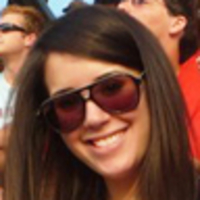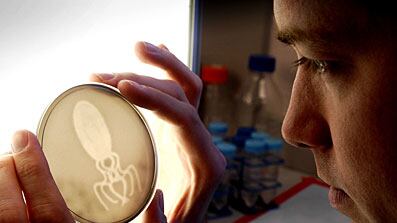Warhol may have been the master of screen prints, Pollock of splatter paint, and Seurat of minute dots of color, but in the case of the artists behind the latest crop of microbial masterpieces, E. coli tends to be the material of choice. Within the confines of their labs, scientists from California to Japan have been manipulating simple, single-cell forms—from bacteria to yeast to viruses to fungi to protists—to create something beautiful out of what is often seen as ugly, dangerous, or even deadly.
Click Image to View Our Gallery of Microbial Art

This crossover art form, however, is nothing new. In the early 1900s, Nobel Prize-winner and father of penicillin Sir Alexander Fleming used pigments from living bacteria to generate his own masterpieces. But today’s microbial masterminds using tiny organisms to create aesthetically pleasing projects are even more experimental, radical, and creative under their lab coats.
“I don’t consider myself an artist, just a scientist who enjoys exploring artistic outlets for creativity,” says Dr. T. Ryan Gregory of Canada’s University of Guelph. He is also the founder of MicrobialArt.com, a website he launched in October that now serves as a central hub for those using E. coli and other deadly microorganisms as artistic materials. “It shows just how many people are exploring this medium and how many ways it has been used,” Gregory explains.
Because the scientists are using living materials, the “paint” dies quickly, rendering the works only temporary. MicrobialArt.com allows more eyes to view the disappearing fungi-centric pieces in all their glory.
While Gregory and his lab use small paintbrushes and E. coli in a liquid medium to create their masterpieces, which include interpretations of Charles Darwin and the HMS Beagle, other scientists are developing their own methods. Dr. Jeff Tabor describes his process using synthetic biology as “kind of like putting together Legos.” The postdoctoral fellow at the University of California, San Francisco is modest about the incredible photos he helped engineer using E. coli, which he admits they tried “without any regard for its actual feasibility.” “The method combines technologies that have been developed over the last 30 or so years of molecular biology,” Tabor explains. “There is really nothing novel in the methods. The only novelty is in what parts we put together.” Although the scientist says self-deprecatingly, “Using any kind of traditional medium, I am probably the worst artist I know,” using this one, he’s turned into a rock star. Tabor was part of a team at the 2004 Synthetic Biology competition that developed the world’s first biological photographic film from retooling bacteria to produce photosensors. As a member of the University of Texas at Austin and University of California, San Francisco team, Tabor helped create the image Hello World, a tribute to the traditional first phrase a computer programmer uses when learning a new programming language.
“We stand on the shoulders of scientific giants. Decades of brilliant work by molecular biologists have put us where we are today,” says Tabor. Now artists are taking notice of these scientific strides. Susan Boafo, a senior lecturer for the BA (Hons) Photography program at the University College Falmouth in the U.K., wanted to bring attention to ecological issues through her art. “I was fascinated by the role of microorganisms in allowing life on Earth to exist,” she says. For her first microbial artwork, Speaking with the Sun, millions of aquatic microorganisms swam toward a light shining through a series of stencils. As the microbes moved toward the light to carry out photosynthesis, they projected the image of the stencil.
German artist Edgar Lissel took a similar approach. He has long worked with different types of photography, including pinhole cameras and camera obscura. For the past decade, he has used the phototropic properties of cyanobacteria to produce images in Petri dishes. When the bacteria move out of the shadowed areas, they grow and project Lissel’s desired image, like with his first work, Water Light(s) History, featuring a destroyed WWII submarine bunker in the German harbor town of Kiel. “The ephemeral and vanishing character of the bunker was mirrored in the creation of the image through the bacteria,” Lissel says. “Both the original and the image exist only in the reproduction. The bunker was completely destroyed soon after. The bacteria image could only be kept through the photography.”
Artist JoWOnder made a similar statement with 6 Days Goodbye Poems of Ophelia, a video installation of her contemporary, bacterial take on John Millais’ painting of Ophelia, which comments on the impermanence and the interconnectedness of all life. With the help of microbiologist Dr. Simon Park, Wonder was able to bring her vision of death to life. “I’ve always been fascinated by the idea of death and dying, and actually I think for me life is probably more frightening than death in the sense that, who knows where our bodies begin and where our bodies end,” she says. And working with live forms created a new challenge. “Most people don’t understand that the essence of great creativity is to have a balance between controlling something and letting it be true to the substance that it is created out of,” Wonder says. “Painting in bacteria is most exciting when you can’t completely control it.”
Fungal-focused works have minds of their own and only last for a few hours or days, but it’s that fleeting quality, that volatility, that creates a perfect merger of scientific researchers and artistic minds. “The growing collaboration between artists and scientists has been such an important development,” Susan Boafo says. “The two disciplines can inform each other, hopefully, bringing about greater appreciation and understanding of the beauty and fragility of our world.”
Jaimie Etkin is an assistant culture editor at the Daily Beast.






